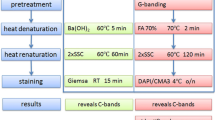Abstract
In L. pardalinum, narrow bands of quinacrine fluorescence are distributed throughout the chromosomes. These vary in intensity from dull to bright, and their constant pattern allows all chromosomes to be recognized. Bright bands occur at some centromeres, and near all three nucleolar constrictions. In L. longiflorum, similar Q-bands occur along chromosomes, but they are less distinctive and their pattern does not closely match that of L. pardalinum. Also, L. longiflorum does not have bright regions at or near primary and secondary constrictions. Most Q-bands do not coincide with dark Giemsa C-bands, except for the bright nucleolar and centromeric regions in L. pardalinum. All C-banded heterochromatin stains identically after SSC pretreatment, dark with Giemsa and bright with quinacrine.— The many Q-bands of varying intensity, wide distribution and constant pattern, unrelated to C-bands, may be analogous to mammalian Q-bands. Such universality is expected if Q-bands area fundamental component of chromosome architecture.
Similar content being viewed by others
References
Caspersson, T., Farber, S., Foley, G.E., Kudynowski, J., Modest, E.J., Simonsson, E., Wagh, U., Zech, L.: Chemical differentiation along metaphase chromosomes. Exp. Cell Res. 49, 219–222 (1968)
Caspersson, T., Zech, L., Modest, E.J., Foley, G.E., Wagh, U., Simonsson, E.: Chemical differentiation with fluorescent alkylating agents in Vicia faba metaphase chromosomes. Exp. Cell Res. 58, 128–140 (1969a)
Caspersson, T., Zech, L., Modest, E.J., Foley, G.E., Wagh, U., Simonsson, E.: DNA-binding fluorochromes for the study of the organization of the metaphase nucleus. Exp. Cell Res. 58, 141–152 (1969b)
Comings, D.E., Kovacs, B.W., Avelino, E., Harris, D.C.: Mechanisms of chromosome banding V. Quinacrine banding. Chromosoma (Berl.) 50, 111–145 (1975)
Evans, H.J.: Uptake of 3H-thymidine and patterns of DNA replication in nuclei and chromosomes of Vicia faba. Exp. Cell Res. 35, 381–393 (1964)
Gagné, R., Tanguay, R., Laberge, C.: Differential staining patterns of heterochromatin in man. Nature (Lond.) New Biol. 232, 29–30 (1971)
Ganner, E., Evans, H.J.: The relationship between patterns of DNA replication and of quinacrine fluorescence in the human chromosome complement. Chromosoma (Berl.) 35, 326–341 (1971)
Horn, J.D., Walden, D.B.: Fluorescent staining of euchromatin and heterochromatin in maize (Zea mays). Canad. J. Genet. Cytol. 13, 811–815 (1971)
Natarajan, A.T., Natarajan, S.: The heterochromatin of Rhoeo discolor. Hereditas (Lund) 72, 323–330 (1972)
Paris Conference (1971): Standardization in human cytogenetics. Birth defects: Original article series, Vol. 8, No. 7. New York: The National Foundation 1972
Schweizer, D.: Differential staining of plant chromosomes with Giemsa. Chromosoma (Berl.) 40, 307–320 (1973)
Schweizer, D., Nagl, W.: Heterochromatin diversity in Cymbidium and its relationship to differential DNA replication. Exp. Cell Res. 98, 411–423 (1976)
Stewart, R.N.: The morphology of somatic chromosomes in Lilium. Amer. J. Bot. 34, 9–26 (1947)
Vosa, C.G.: Heterochromatin recognition with fluorochromes. Chromosoma (Berl.) 30, 366–372 (1970)
Vosa, C.G.: The quinacrine-fluorescence patterns of the chromosomes of Allium carinatum. Chromosoma (Berl.) 33, 382–385 (1971)
Vosa, C.G.: Heterochromatin recognition and analysis of chromosome variation in Scilla sibirica. Chromosoma (Berl.) 43, 269–278 (1973)
Vosa, C.G.: The use of Giemsa and other staining techniques in karyotype analysis. Curr. Advanc. Plant Sci. 14, 495–510 (1975)
Vosa, C.G.: Heterochromatic banding patterns in Allium II. Heterochromatin variation in species of the paniculatum group. Chromosoma (Berl.) 57, 119–133 (1976)
Vosa, C.G., Marchi, P.: Quinacrine fluorescence and Giemsa staining in plants. Nature (Lond.) New Biol. 237, 191–192 (1972)
Yamasaki, N.: Differentielle Darstellung der Metaphasechromosomen von Cypripedium debile mit Chinacrin- und Giemsa-Färbung. Chromosoma (Berl.) 41, 403–412 (1973)
Author information
Authors and Affiliations
Rights and permissions
About this article
Cite this article
Kongsuwan, K., Smyth, D.R. Q-bands in Lilium and their relationship to C-banded heterochromatin. Chromosoma 60, 169–178 (1977). https://doi.org/10.1007/BF00288463
Received:
Accepted:
Issue Date:
DOI: https://doi.org/10.1007/BF00288463




